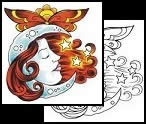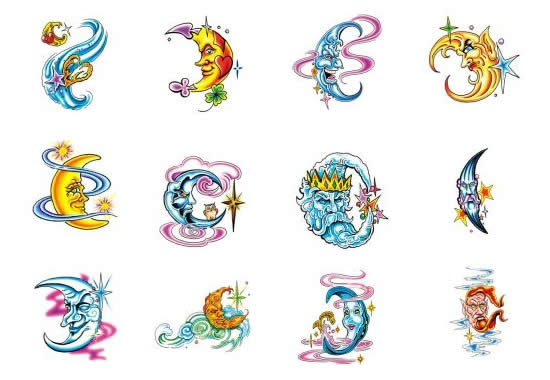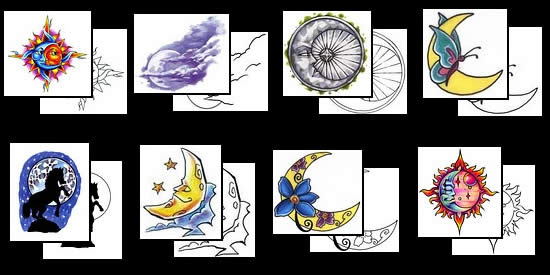|
|
|||
 |
|||
|
TATTOO DESIGNS & SYMBOLS - MOON TATTOOS
Tattoo Symbol Index - A B C D E F G H I J K L M N O P Q R S T U V W X Y Z Tattoo designs - M >> Moon
The Assyrians held the moon to be the supreme deity, while Moon worship existed in Ancient Greece, Babylonia, India and China. The belief was based on the observation of how the moon's phases affected the growth and decline of crops, and of animal and human life. Little wonder then that the power of the Moon was seen as divine. Because the cycles and phases of the Moon are so predictable, the Moon played a prominent role in the earliest concepts of time and calendars, and the Lunar Calendar was used by many cultures to plan religious ceremonies around, and to time the planting and harvesting of crops. In the Northern Hemisphere, the Harvest Moon, is the full moon that occurs nearest the autumnal equinox on September 23, and usually takes place in late September or early October. This Full Moon was often closely associated with the fall harvest of grain and other crops, hence its name and many celebrations took place at this time of the year. During the period of the Harvest Moon, the retardation (later rising each night) of the moon is at a minimum, because of the relation of the moon's path to the horizon. On several nights in succession the moonrise is at nearly the same time, and there is full moonlight almost from sunset to sunrise if the sky is unclouded. The Hunters Moon was the name given to the first full moon after the Harvest Moon. It often signaled the period when animals that migrated, either herd animals or birds, began to be hunted in earnest for food stores for the winter ahead. Like the Harvest Moon, the Hunters Moon is very bright and on cloudless nights it was said a good hunter could track his prey as if by daylight. Because the Hunters Moon was bright enough to hunt by, it was also occasionally referred to as the Blood Moon. The expression "once in a Blue Moon", symbolizes rarity. A Blue Moon is the third full moon in a three-month calendar season that has four full moons, or the second of two full moons occurring in the same month. These are events that do not happen within a relatively long period of time. To honor the moon, Greeks built temples dedicated to Diana, or Artemis, as she was known to the ancient Greeks. For the Celts, Morgana was the Moon goddess. The Mayan Moon goddess was the patroness of pregnant women. In aboriginal cultures, Grandmother Moon is seen holding her generous, round bowl. In Japan they do it differently -- the moon was associated with the male god, Susanowo, brother of the Amateratsu, the goddess associated with the sun. Astrologers point to the moon as the ruler of the emotions, characterized by fickle changes and fluctuations. Both East and West associate the moon with the mother, nurturing, and the home. It is universally associated with water and tides and the female cycles of menstruation. The moon looks outwards, shining its light on others, which has become synonymous with the traditional feminine principles of care-giving and comforting others. Receptivity and melancholy are also seen as 'moon aspects' but in no way associated with any dwindling of power. In China, the moon is the Yin (feminine) principle, and in Indian astrology, the moon represents the mind. It is still customary among women in Central Africa to bathe their newborn infants in the light of a full moon. The mythical werewolf knows better than anyone about the power of the moon. We are endlessly fascinated by terrifying tales of its transformation into a lupine creature under the influence of the full moon. In different parts of the world, the moon is the star of many tales of romance and lunacy. Kissing someone under a Full Moon is considered to be a lucky portent for the length and strength of the relationship. The Bushman of Africa has the story of the moon and the rabbit, with the rabbit as mischief maker and the moon representing Eternity. In the West, being 'moonstruck' refers to the belief that madmen have been stricken by the moon's power. The word Lunatic emerged from that association. The Moon is also closely associated with the many animals that come out at night, particularly to hunt. Wolves, coyotes, panthers, jaguars, leopards, owls, bats and many other creatures that go bump in the night have all been associated with the Moon. In some Native American cultures it is thought that wolves and coyotes are 'howling' at the Moon when they make their familiar cries that are actual territorial boundaries. The plains and craters of the moon, their various shapes and shades, have been interpreted by different cultures as either 'the man in the moon', or in some cases, the 'rabbit' or 'buffalo', etc. With the advent of scientific investigation, man's view of the moon began to change. Some of the first philosophers and astronomers to challenge the old beliefs were imprisoned, or worse, for their new theories. After the invention of the telescope around 1608, the moon acquired a different image and shed some of its supernatural mystique. Interest in its more material and physical aspects - cheese, anyone? -- grew rapidly over the centuries, until the day the moon had a visit from the Man on the Earth, Neil Armstrong, in 1969. See also, Crescent Moon and Star Tattoos, Sun Tattoos, Star Tattoos
Choose your own
classic moon tattoo design at Tattoo-Art.com. Pick out your Moon Tattoo design at TattooJohnny.com Tattoo designs - M >> Moon Tattoo Symbol Index - A B C D E F G H I J K L M N O P Q R S T U V W X Y Z |
||
| Celeb Tattoos | Facts & Stats | Designs & Symbols | History | Culture | Links | Tattoo Galleries | Contact | |||
|
|
|||





